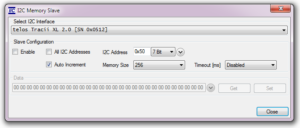Facts I2C High Speed Slave
I2C High-Speed Slave
In addition to the tracer and master mode telos Tracii XL 2.0 also features a sophisticated I2C slave device. This integrated component supports all I2C speed modes: standard speed, fast mode, fastmode plus and high-speed mode.
This makes the I2C slave one of the rare devices on the market which offer a standard memory interface supporting I2C high speed and beyond
Transfers with up to 3.6 Mbit/s are supported without clock stretching which is even beyond the maximum allowed speed in high-speed mode according to the I2C specification. This lets you test your I2C equipment with a safety margin against maximum ratings.
The slave device mimics the behavior of a standard I2C RAM but without hardware related restrictions. The slave address is highly configurable using a seven or ten bit address scheme.
Asynchronous reading and writing of data is supported from within the PC software allowing for external manipulation of the memory contents.
Since the I2C slave is fully independent of other modes it can be used in parallel to any master or tracer operation. It is therefore possible to exercise the slave with the master of the same telos Tracii XL 2.0 and monitor that transfer with the tracer in the same box.
Key features of the high speed I2C slave at a glance:
- High-speed transfers up to 3.6 Mbit/s without stretching
- Configurable 7-Bit or 10-Bit address
- Configurable Memory Size (1-256 Byte)
- 1.0 (one!) to 5.5 Volt
- Auto increment of the internal address pointer (can be disabled)
- Master, tracer and slave can be used simultaneously in one telos Tracii XL 2.0
Use Cases
Our I2C slave device is useful in two main situations:
- You have developed an I2C master which you need to exercise against an I2C high speed device
- You want to test your I2C master even with speeds higher than the defined maximum for the I2C high speed mode
- You need to simulate a non-existing slave device which can be mapped to the function of a standard RAM i.e. has a set of registers being addressed in the range 0..255
What you need
You need nothing more than your telos Tracii XL 2.0.
No options are required!

